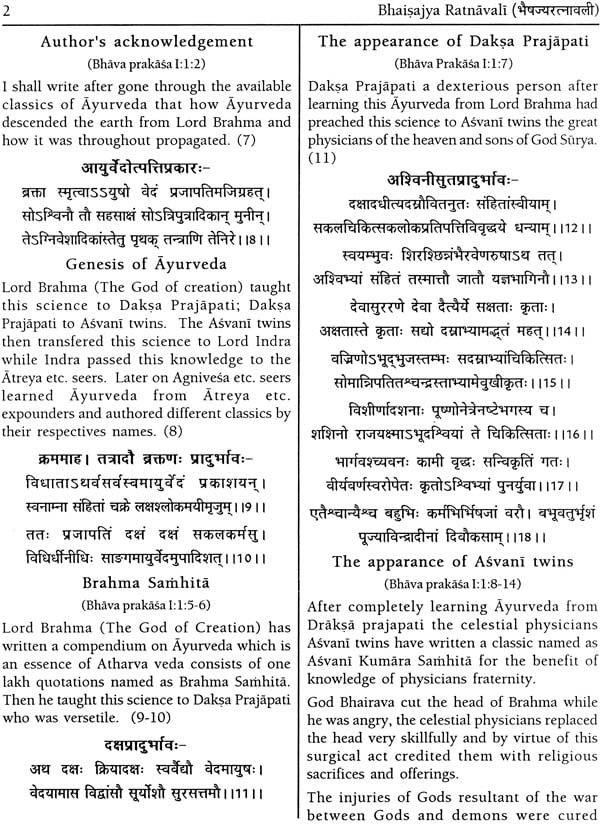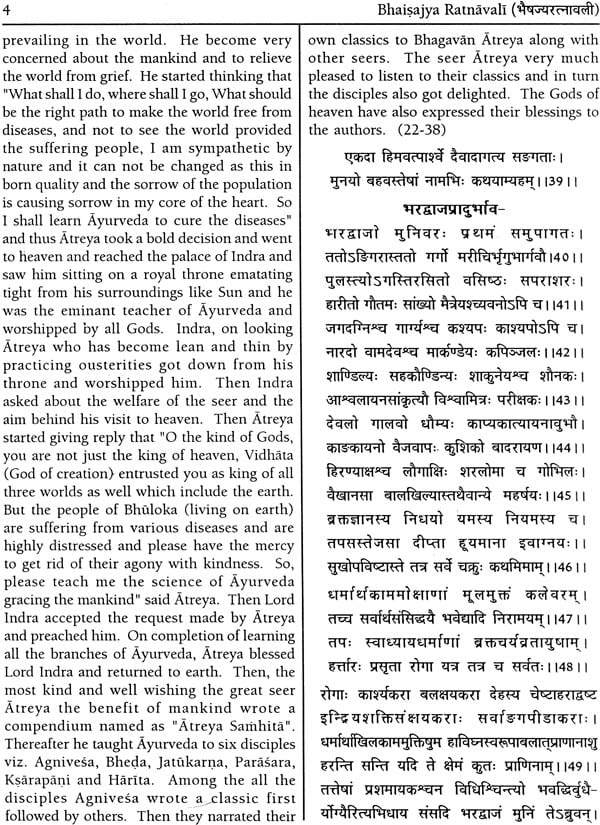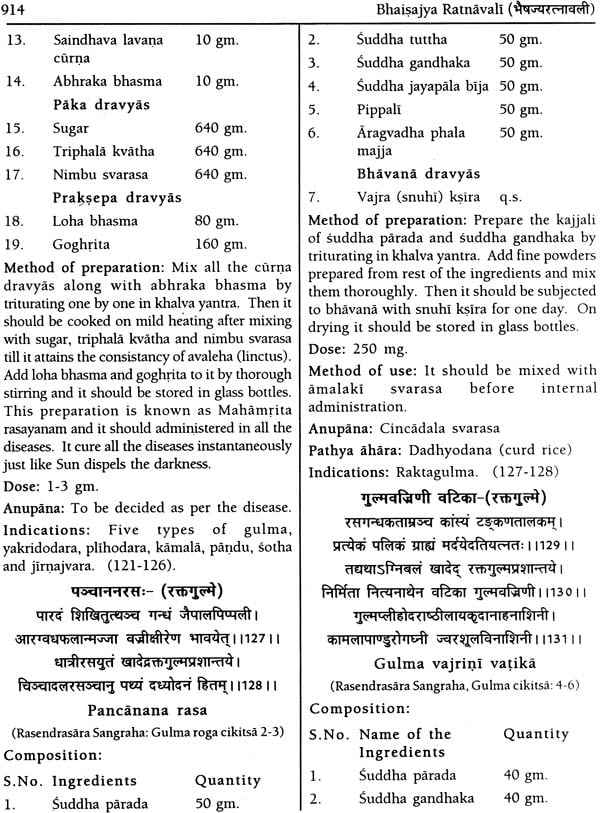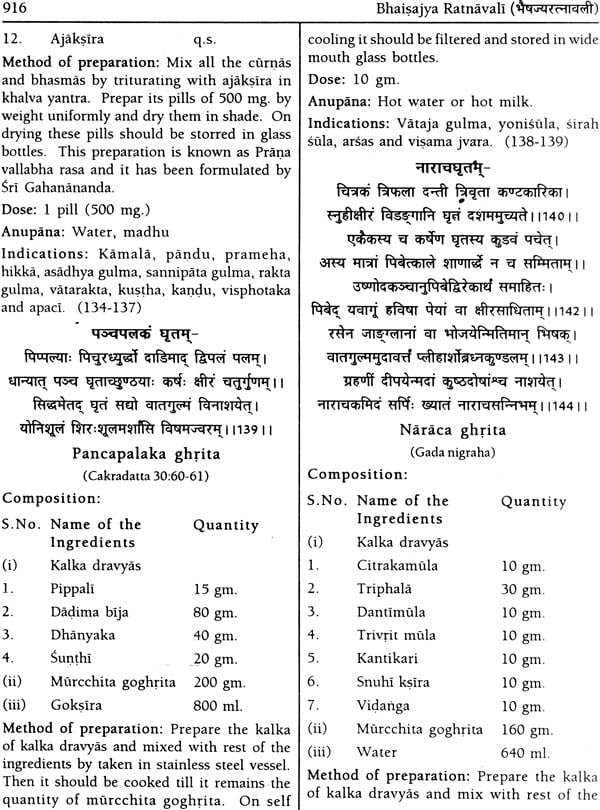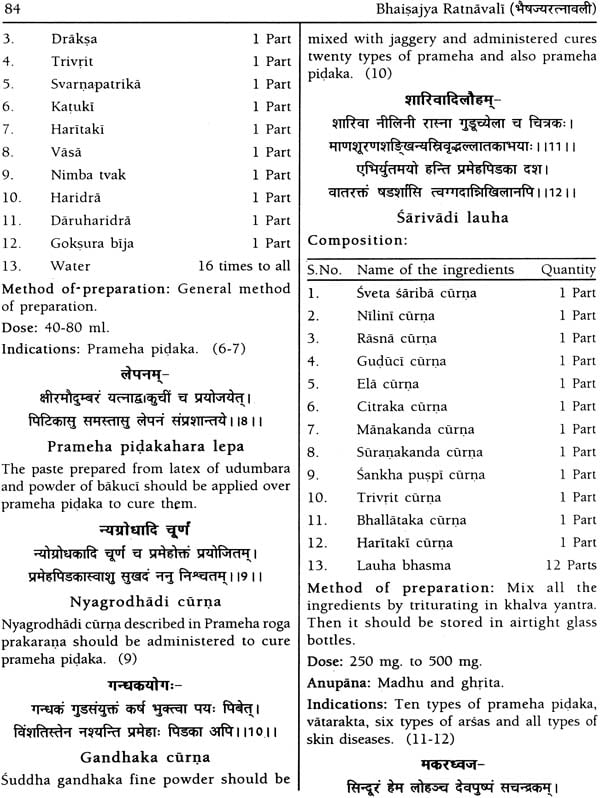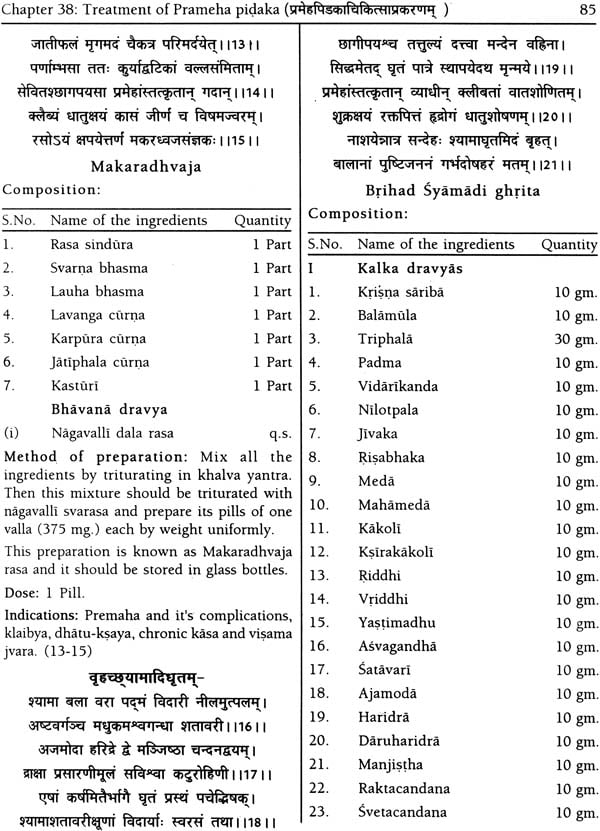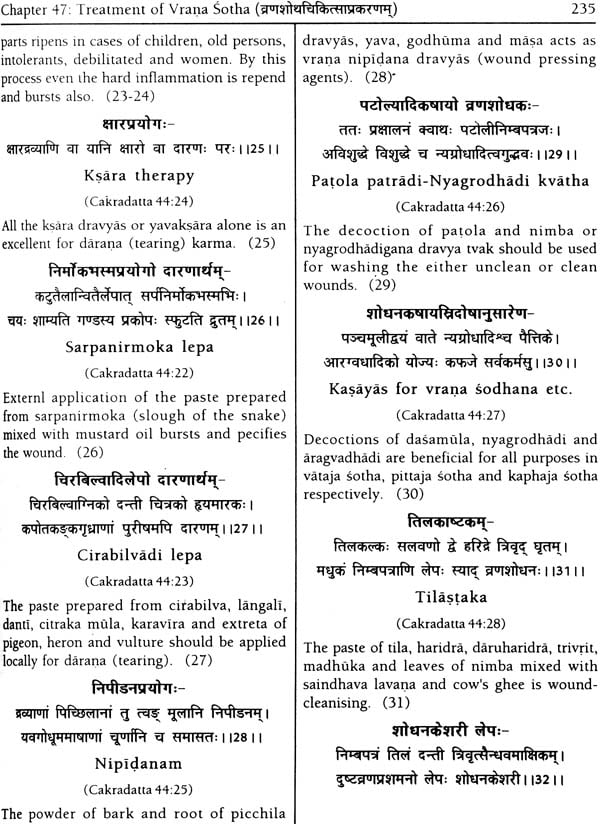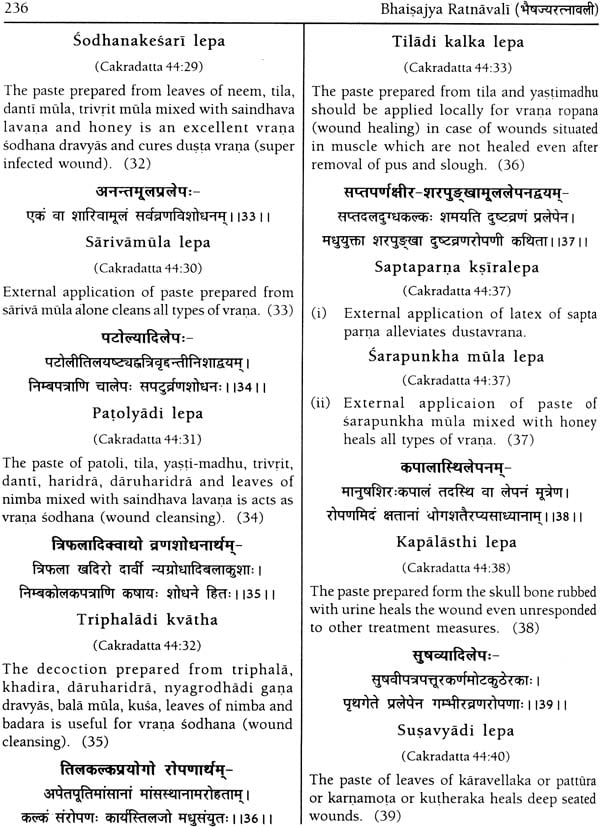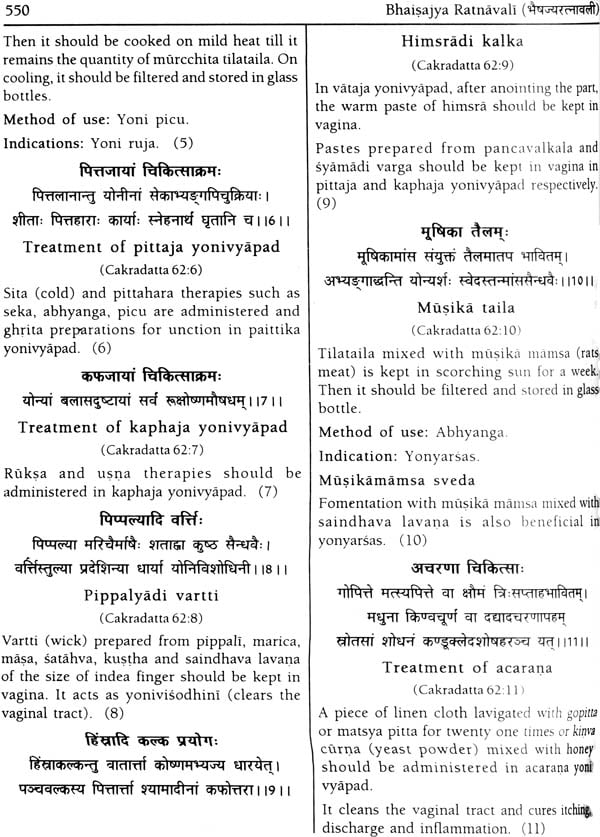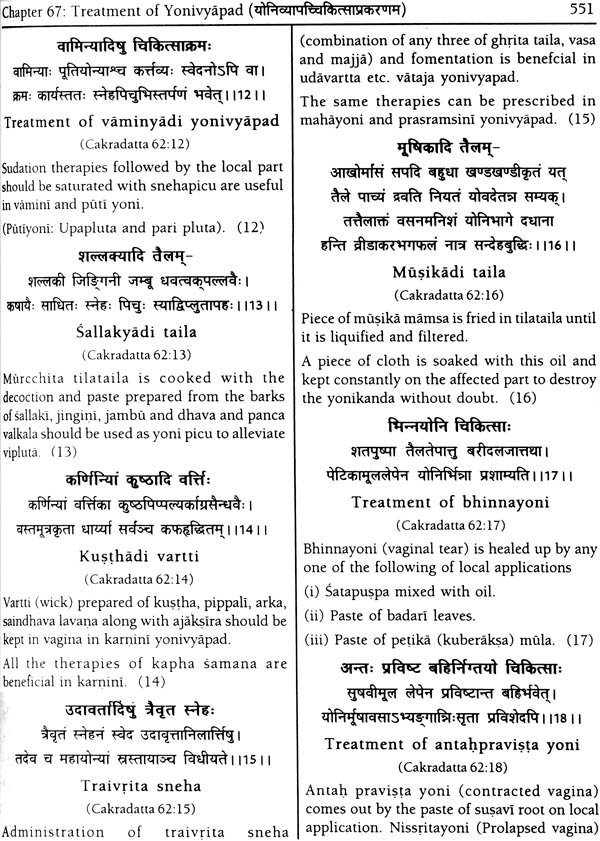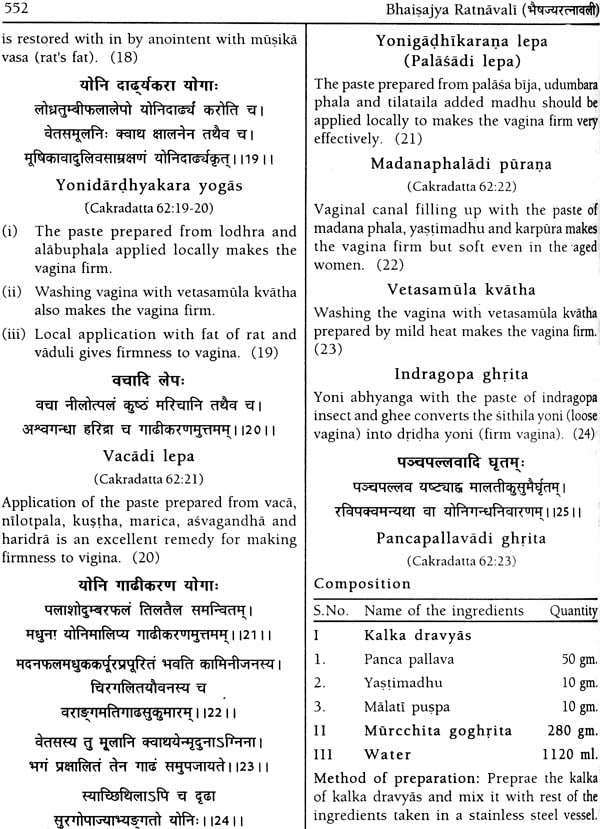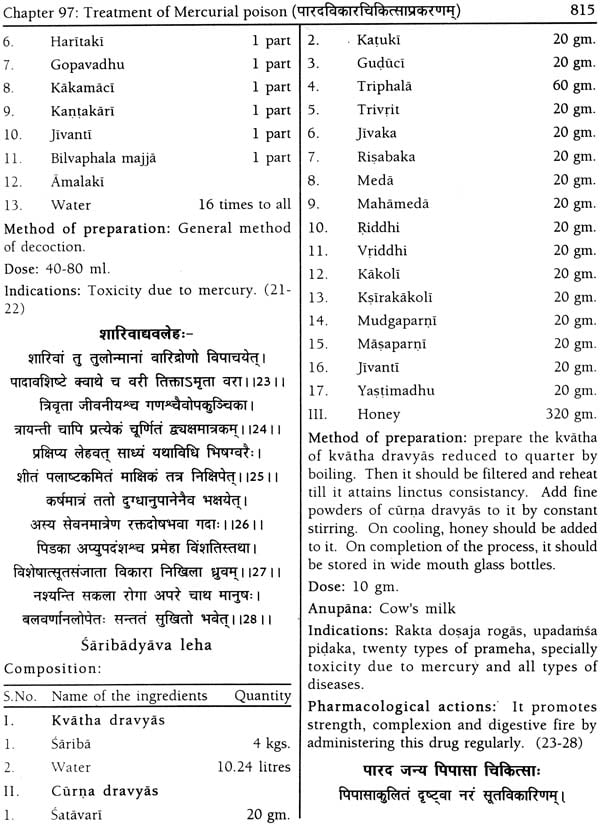
Bhaisajya Ratnavali of Kaviraj Shri Govind Das Sen (Set of Two Volumes)
Book Specification
| Item Code: | NAG135 |
| Author: | Dr. G. Prabhakara Rao |
| Publisher: | CHAUKHAMBHA ORIENTALIA, Varanasi |
| Language: | Sanskrit Text with English Translation |
| Edition: | 2014 |
| ISBN: | 9788176373074 |
| Pages: | 942 |
| Cover: | Hardcover |
| Other Details | 10.0 inch X 7.5 inch |
| Weight | 3.80 kg |
Book Description
Bhasiajya Ratnavali is one of the most important classical in Ayurveda written by Sri Govinda Das Sen. This is a compendium of doctrines, disease, diagnosis, drugs and diet apart from behavioural regimen attributed in different conditions. This book is a treasure house of Pharmaceutics, as it deals with very simple drug formulations to highly complex formulations, commonly used preparations, tested and trusted, experienced by great scholars. Most of the Ayurvedic drugs are available in the market in India as well as abroad and also in AFI (Ayurvedic Formulatory of India) are taken from Bhaisajya Ratnavali. This book is as essential as Bhagvad Gita for the pure Ayurvedic Physicians and Ayurvedic drug manufactures as well. This book is also an ornament to the academicians, students of under graduation, post graduation and doctorate level also as it deals with more than 100 diseases, thousands of formulations of herbal and mineral preparations. The asset of this book is inclusion of very single ingredient svarasa preparations to multiple ingredients of rasausadhies in order to give the scope to select the formulation as per the need of the physician based on the condition of the patient.
The English translation of this highly praised classic “Bhaisajya Ratnavali” is done by Dr. G. Prabhakara Rao who is post graduate and doctorate in Rasa Shastra and Bhaisajya Kalpana from the Faculty of Ayurveda, Institute of Medical Sciences and Banaras Hindu University. He presented this book in very systematically and methodically in two volumes. Maximum cross references, clarity of the text and modern measurements in formulations and schematic presentation of the formulations are few salient features of his translation. This book is highly useful for the practitioners of Ayurveda, drug manufacturers, student fraternity, teaching faculty and researches as it contain all the essential subjects of Ayurveda.
Dr. G. Prabhakara Rao born on 01-07-1964 to the parents Vaidya Sri Gonugunta Ramanaiah and Sitharamulamma at Botlagudur village Prakasam district, Andhra Pradesh, India; did his BAMS from Dr. N. R. S. Govt. Ayurvedic College, Vijayawada, Andhra Pradesh and both M.D. (Ayu) Ph.D. (Ayu) with specialization in Rasa shastr from IMS, BHU. He is presently working as Chief Medical Officer (NFSG) at Employees State Insurance Corporation (ESIC) (under Ministry of Labor and Employment, GOI), New Delhi. He was the best scholar throughout his academics. His direct and indirect mentor-ship helped many students whose-ever preparing for ayurvedic post graduate/competitive examinations through his books. He received many awards namely few, Dhanwantari award, Pt. Ramnarayana Sharma memorial award, Gold medal, Achayra Nagarjuna Silver Medal etc., He authored 15 books and many scientific articles on ayurveda in various national and international journals and delivered many lectures at various platforms. He has many contributions to the field of Ayurveda through his writings. Delivered talks on Ayurveda in All Indi radio, Television channels and articles on Ayurveda are published in News papers. He is the contributing expert for many of the workshops organized by Rashtriya Ayurveda Vidyapeeth, New Delhi. His clinical expertise helped many ailing patients. In to, his multidimensional outlook helped different stakeholders of Ayurveda through his lectures, writings, expertise suggestions, visionary goals etc.,
Bhaisajya Ratnavali is one of the most popular and authentic compendia of Ayurveda. almost all the Ayurvedic physicians are following the formulations of this classic in their day to day practice. this book is a treasure house of pharmaceutical preparations and almost all the Ayurvedic drug manufacturers are followed to prepare the drugs based on descriptions mentioned in this text. Quite a huge number of formulations of this text are incorporated in Ayurvedic Formulary of India published by Government of India, Deptt. of Ayush, Ministry of Health and Family Welfare, New Delhi.
The beauty of this compendium is that it includes very simple preparation like svarasa (expressed juice) to high technical preparation like kupipakva rasayanas to serve the needs of Ayurvedic physicians and to treat the different stages of disease.
This classic comprising of one hundred six chapters dealing with mainly treatment principles, different formulations i.e. herbal, mineral, metallic and combinations, various pharmaceutical forms viz.Svarasa, kalka, kvatha, hima, phanta, rasakriya, avaleha, ghrita, taila, asava, arista, bhasma, kharaliya rasayana, kupi pakva rasayana, parpati, ksara, lavana etc. Non phrmacological treatments are also find place in certain diseases like jvara, unmada, apasmara, hikka and graha roga etc. diseases.
Some new chapters like Virya stambhana, Amasaya roga cikitsa, Smaronmada cikitsa, Gadodvega cikitsa, Tattvonmada cikitsa, Acalavata cikitsa, Tandava roga cikitsa, Snayu roga cikitsa, Skhalitya cikitsa, Khanjanika cikitsa, Urostoya cikitsa, Bahumutra cikitsa, Soma roga mutratisara cikitsa,Sukrameha cikitsa, Ojomeha cikitsa, Lasikameha cikitsa, Dhvaja bhanga cikitsa, Vrikka roga cikitsa, Snayuka roga cikitsa, Parada vikara cikitsa, Sirsambu roga cikitsa, Mastiska vepana cikitsa, mastiskacayapacaya cikitsa, Mastiska roga samanya cikitsa, Amsughata roga cikitsa, Yosapatantraka cikitsa, Yoni kandu cikitsa, Andadhara roga cikitsa and Apamumursu cikitsa are incorporated in this work inorder to facilitate the treatment and to promote Ayurveda. At the end of the each chapter the description of pathya and apathya are also given as a part of treatment.
English translation and Sri Ramana Prabhakara commentary is a dream of the translator. During my under graduation studies though i wanted to refer this book i could not do this due to lack of Hindi knowledge. Later on by the grace of Lord Vishwanath, I took the admission in M.D. (Ay.)Rasa Shastra in B.H.U. Varanasi and I got the opportunity to learn Hindi language some extent and I have gone through this text thoroughly during my M.D. and Ph.D. studies. In the year 1991 I translated Rasamritam written by Vaidya Shri Yadavji Trikamji acarya, alongwith my guruji Prof. Damodar Joshiji and I got some command on terminology and concepts related to Rasa Shastra and Bhaisajya Kalpana. Subsequently I wrote the text book on Bhaisajya Kalpana Vijnanam (based on CCIM Syllabus). These two works gave me a scope to translate this big voluminous Bhaisajya Ratnavali and my dream comes true after completion of twenty five years (silver jubilee year) of my graduation.
Although this book is not included in the syllabus of graduation and post graduation curriculum. However, most of the scholars, teachers, researchers and physicians are referred this book particularly for formulations. Though these formulations are available in earlier classics like Caraka Samhita, Susruta Samhita, Harita Samhita, Sarangadhara Samhita, Cakradatta, Rasendra Sara Sangraha, Brihat Rasaraja Sundara, Rasaratna Samucchaya, Yoga Ratnakara etc. but this compendium gained popularity due to its comprehensiveness. The well tested and trusted composition of various formulations of earlier classics are incorporated in this text as mentioned by the author Kaviraj Govind Das SenJi in order to promote Ayurvedic practice and also made it physician friendly.
This classic is presented into two volumes for the convenience of readers and better handling. In volume one the chapter one to thirty two are presented and rest of the chapters along with six appendices such as Glossary of drugs (plant origin), Plants and their botanical names, Animal origin products, Minerals and metals, Diseases with modern equivalents and Measurements presented in volume two in a lucid manner.
The presentation style followed in this translation is definately first of its kind in Ayurveda. Inclusion of maximum nomenclature to untold paragraphs, categorisation of ingredients in different formulations, incorporation of accurate references, schematic presentation of formulations, incorporation of accurate references, schematic presentation of formulations and dual index (index with reference as well as page number) are few salient features of this book.
I hope this work is definitely useful to Ayurveda fraternity including students, teachers, practitioners, researchers and drug manufacturers.
| Chapter 1 | Origin of Ayurveda | 1-8 |
| Chapter 2 | Purification and incineration of metals and minerals | 9-31 |
| Chapter 3 | Micellaneous subjects | 32-38 |
| Chapter 4 | Terminology | 39-53 |
| Chapter 5 | Treatment of Fever | 54-243 |
| Chapter 6 | Treatment of Jvaratisara | 244-262 |
| Chapter 7 | Treatment of Atisara | 263-295 |
| Chapter 8 | Treatment of Grahani roga | 296-382 |
| Chapter 9 | Treatment of Arsas | 383-424 |
| Chapter 10 | Treatment of Agnimandya etc. diseases | 425-473 |
| Chapter 11 | Treatment of Krimi roga | 474-488 |
| Chapter 12 | Treatment of Pandu | 489-512 |
| Chapter 13 | Treatment of Raktapitta | 513-536 |
| Chapter 14 | Treatment of Rajayaksma | 537-584 |
| Chapter 15 | Treatment of Kasa | 585-616 |
| Chapter 16 | Treatment of Hikka and Svasa | 617-635 |
| Chapter 17 | Treatment of Svarabheda | 636-643 |
| Chapter 18 | Treatment of Arocaka | 644-651 |
| Chapter 19 | Treatment of Chardi | 652-656 |
| Chapter 20 | Treatment of Trisna | 657-661 |
| Chapter 21 | Treatment of Murccha | 662-665 |
| Chapter 22 | Treatment of Madatyaya | 666-671 |
| Chapter 23 | Treatment of Daha | 672-675 |
| Chapter 24 | Treatment of Unmada | 676-692 |
| Chapter 25 | Treatment of Apasmara | 693-702 |
| Chapter 26 | Treatment of Vatavyadhi | 703-784 |
| Chapter 27 | Treatment of Vatarakta | 785-812 |
| Chapter 28 | Treatment of Urustambha | 813-817 |
| Chapter 29 | Treatment of Amavata | 818-847 |
| Chapter 30 | Treatment of Sularoga | 848-886 |
| Chapter 31 | Treatment of Udavartta and Anaha | 887-896 |
| Chapter 32 | Treatment of Gulma | 897-923 |
| Chapter 33 | Treatment of Hridroga | 1-14 |
| Chapter 34 | Treatment of Mutrakricchra | 15-27 |
| Chapter 35 | Treatment of Mutraghata | 28-34 |
| Chapter 36 | Treatment of Asmari | 35-45 |
| Chapter 37 | Treatment of Prameha | 46-82 |
| Chapter 38 | Treatment of Prameha pidaka | 83-87 |
| Chapter 39 | Treatment of Medo roga | 88-97 |
| Chapter 40 | Treatment of Udara roga | 98-121 |
| Chapter 41 | Treatment of Plihayakrid roga | 122-154 |
| Chapter 42 | Treatment of Sotha | 155-187 |
| Chapter 43 | Treatment of Vriddhi roga | 188-205 |
| Chapter 44 | Treatment of Galaganda etc. diseases | 206-218 |
| Chapter 45 | Treatment of Slipada | 219-227 |
| Chapter 46 | Treatment of Vidradhi | 228-231 |
| Chapter 47 | Treatment of Vranasotha | 232-246 |
| Chapter 48 | Treatment of Sadyovrana | 247-249 |
| Chapter 49 | Treatment of Bhagna | 250-254 |
| Chapter 50 | Treatment of Nadi vrana | 255-261 |
| Chapter 51 | Treatment of Bhagandara | 262-268 |
| Chapter 52 | Treatment of Upadamsa | 269-280 |
| Chapter 53 | Treatment of Sukadosa | 281-283 |
| Chapter 54 | Treatment of Kustha | 284-344 |
| Chapter 55 | Treatment of Udarda sitapitta and kotha | 345-351 |
| Chapter 56 | Treatment of Amlapitta | 352-373 |
| Chapter 57 | Treatment of Visarpa | 374-378 |
| Chapter 58 | Treatment of Visphota | 379-383 |
| Chapter 59 | Treatment of Masurika | 384-394 |
| Chapter 60 | Treatment of Ksudra roga | 395-426 |
| Chapter 61 | Treatment of Mukha roga | 427-449 |
| Chapter 62 | Treatment of Karna roga | 450-460 |
| Chapter 63 | Treatment of Nasa roga | 461-466 |
| Chapter 64 | Treatment of Netra roga | 467-504 |
| Chapter 65 | Treatment of Siro roga | 505-529 |
| Chapter 66 | Treatment of Pradara roga | 530-548 |
| Chapter 67 | Treatment of Yonivyapad | 549-565 |
| Chapter 68 | Treatment of Garbhini roga | 566-580 |
| Chapter 69 | Treatment of Sutika roga | 581-601 |
| Chapter 70 | Treatment of Stana roga | 602-604 |
| Chapter 71 | Treatment of Bala roga | 605-643 |
| Chapter 72 | Treatment of Visa roga | 644-656 |
| Chapter 73 | Rasayana therapy | 657-680 |
| Chapter 74 | Vajikarana prakarana | 681-733 |
| Chapter 75 | Viryastambha prakarana | 734-737 |
| Chapter 76 | Treatment of disease of stomach | 738-739 |
| Chapter 77 | Treatment of Smaronmada | 740 |
| Chapter 78 | Treatment of Gadodvega | 741-743 |
| Chapter 79 | Treatment of Tattvonmada | 744-745 |
| Chapter 80 | Treatment of Acalavata | 746 |
| Chapter 81 | Treatment of Tandava roga | 747 |
| Chapter 82 | Treatment of Snayu roga | 748-752 |
| Chapter 83 | Treatment of Skhalitya | 753-754 |
| Chapter 84 | Treatment of Khanjanika | 755 |
| Chapter 85 | Treatment of Urastoya | 756 |
| Chapter 86 | Treatment of Bahumutra | 757-766 |
| Chapter 87 | Treatment of Somarogaand mutratisara | 768-769 |
| Chapter 88 | Treatment of Sukrameha | 770-776 |
| Chapter 89 | Treatment of Aupasargika meha | 777-780 |
| Chapter 90 | Treatmenet of Ojomeha | 781-785 |
| Chapter 91 | Treatment of Lasikameha | 786-789 |
| Chapter 92 | Treatment of Dhvajabhanga | 790-798 |
| Chapter 93 | Treatment of Vrikka roga | 799-802 |
| Chapter 94 | Treatment of Kloma roga | 803-805 |
| Chapter 95 | Treatmetn of Phiranga roga | 806-809 |
| Chapter 96 | Treatment of Snayuka roga | 810-811 |
| Chapter 97 | Treatment of Mercurial poison | 812-816 |
| Chapter 98 | Treatment of Sirsambu roga | 817-820 |
| Chapter 99 | Treatment of Mastiska vepana | 821-822 |
| Chapter 100 | Treatment of Mastiska cayapacaya | 823-824 |
| Chapter 101 | General treatment of Brain diseases | 825-830 |
| Chapter 102 | Treatment of Amsughata | 831-834 |
| Chapter 103 | Treatment of Yosapatantraka | 835-837 |
| Chapter 104 | Treatment of Yonikandu | 838-839 |
| Chapter 105 | Treatment of Andadhararoga | 840-841 |
| Chapter 106 | Treatment of Apamumursu | 842-844 |
| Appendixes | 845-897 | |
| Index | 898-933 |

